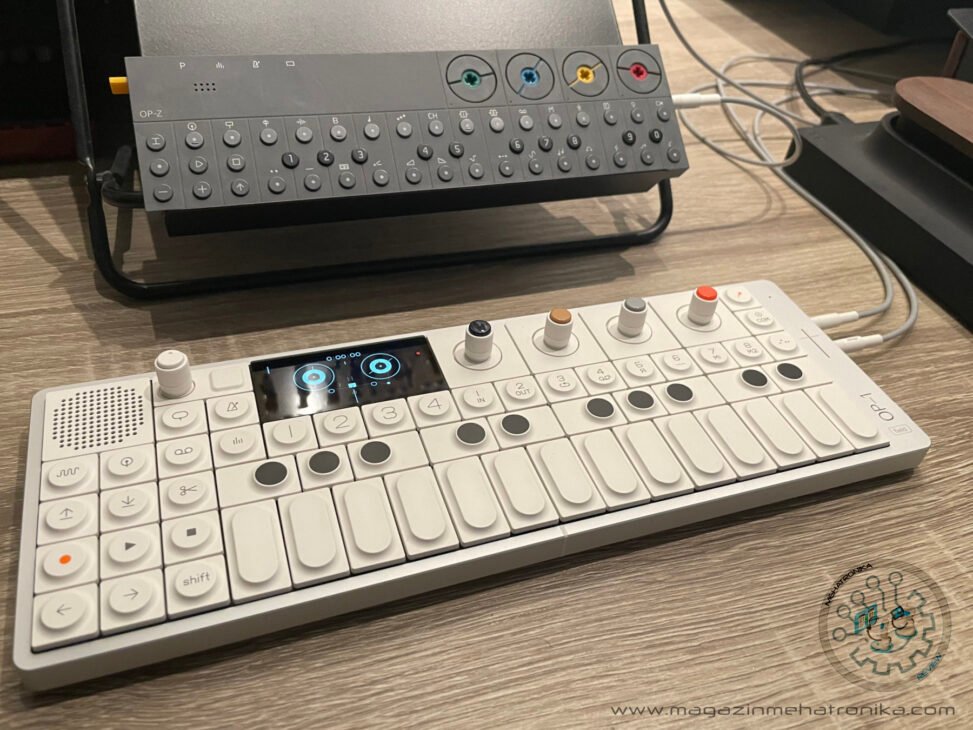There is absolutely no doubt that teenage engineering’s OP-1 is one of, if not the most influential, synthesisers of the decade. However, as we’ve already seen multiple times with the Swedish brand’s products, trying to fit them into a single conventional category doesn’t do them justice. The OP-Z is more than just a sequencer, the TX-6 is more than just a mixer, so it only makes sense for the OP-1 to be more than just a synthesiser.

Photo: magazin Mehatronika
Aside from the legendary synth engines, the OP-1 features a powerful sampler, drum machine, effects processor, sequencer and virtual tape recorder, making the whole package feel much more like a DAW than a simple instrument.
But in all its complexity, the OP-1 manages to avoid losing the sense of immediacy which hardware instruments offer. By forgoing menu diving and endless list scrolling and placing most major elements of the interface just one button press away, this tiny box manages to feel quite natural to use.
But this sense of hands-on control isn’t the only defining characteristic of the OP-1. Perhaps even more important is the curious amount of playfulness and intentional abstraction inherent to the design. Using it, you won’t find yourself precisely setting cutoff frequencies or modulation amounts, but rather interacting with unique parameters using the four iconic rotary encoders (which we’ll mention in more detail later in the review).
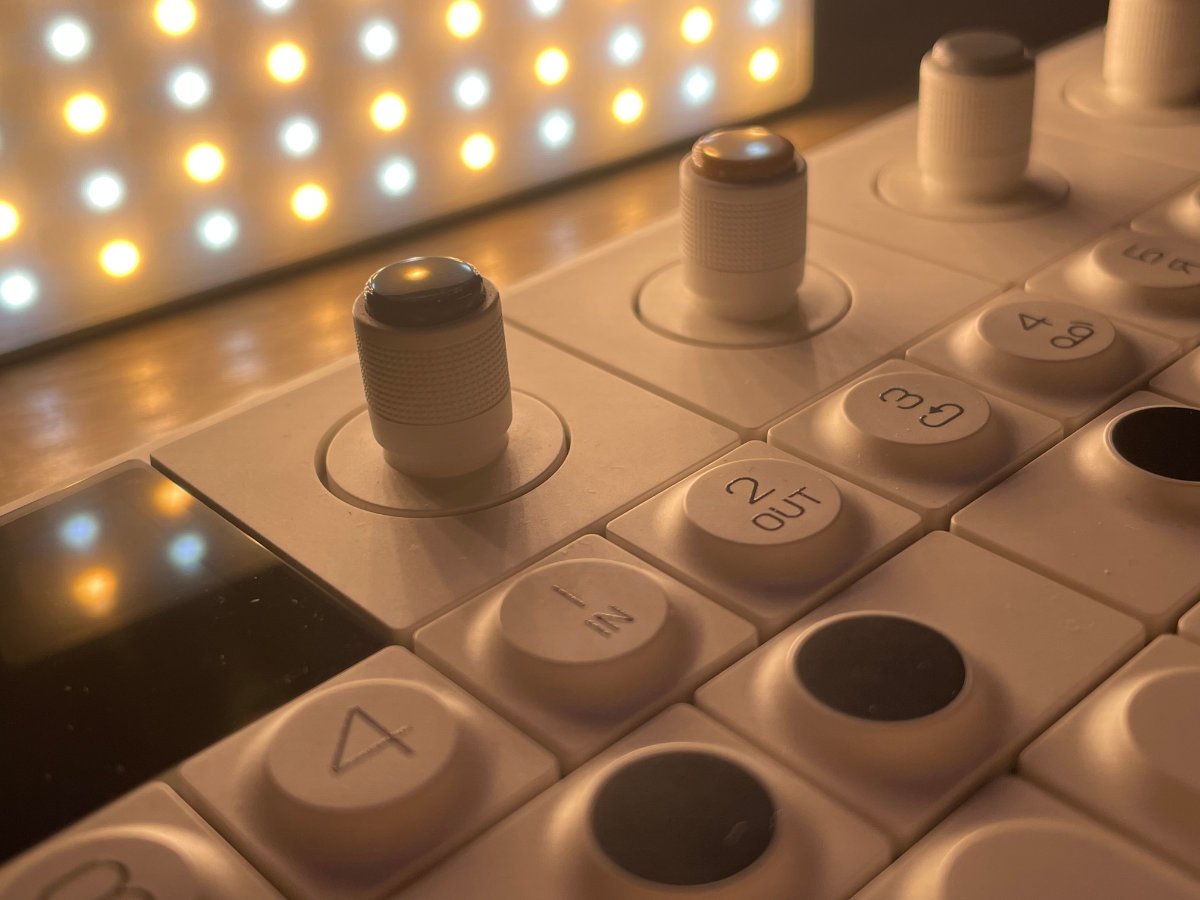
Photo: magazin Mehatronika
These two core ideas majorly shape OP-1’s one-of-a-kind workflow which prioritises sound itself over any concrete technical aspects of music creation. “Happy accidents” are also paramount here: the virtual tape recorder, OP-1’s main track-creation feature, lacks an undo key, but features tape splicing and joining tools, faithfully emulating how true analog tape recorders of the old used to work (we’ll dig a little more into the specific functionality of the virtual tape later, as well).
The OP-1 field
As of this writing, the OP-1 is well over a decade old. While its concept and execution are timeless, the aging hardware powering the instrument was starting to show its shortcomings, prompting teenage engineering to push out an improved version, dubbed the OP-1 field in 2022. With newer and faster internals, better sound and tons of general design and quality-of-life improvements, it represents a true generational leap. However, it’s still essentially the same quirky and fun mobile music workstation — but now with over a decade’s worth of new tech inside.
Teenage engineering’s website claims that the new OP-1 field is “a 100 times better” than its predecessor, and then proceeds to list a hundred reasons why. This is more of a quirky marketing gimmick, however, as some of the listed improvements don’t hit quite as hard as others — and some of the listed changes feel a bit repetitive. Quirky marketing aside, this is not to say that many major improvements haven’t been made.
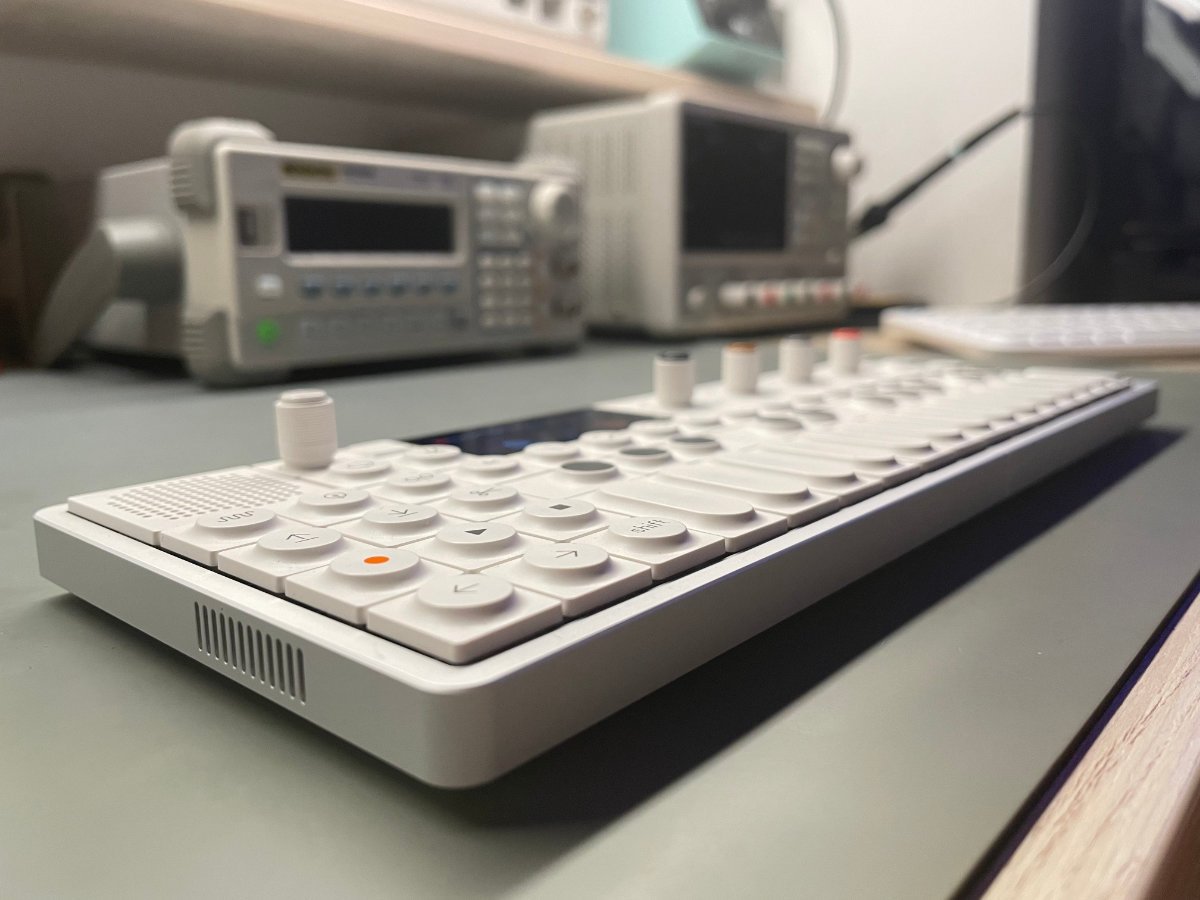
Photo: magazin Mehatronika
For starters, the OP-1 field has a fully stereo 32-bit signal path, which is a notable improvement over the 24-bit (mostly) mono setup of the original OP-1. To achieve this, a spec bump in processing power was required, and RAM was also quadrupled from 64 MB to 256 MB. Additional hardware upgrades include the new higher-resolution screen (which is, sadly, no longer an OLED, but an LCD display), a more modern I/O setup which now features USB-C, a much better speaker system, built-in Bluetooth and several more features.
A notable and rather unique addition is the radio transmitter. Unlike the original OP-1, the field can start its own FM radio station, which can be used to hook it up to a car stereo or te’s own OB-4 radio speaker. It’s a low power transmitter, so it should comply with most country regulations, and is nice way to achieve low-latency audio streaming, obtain some authentic radio sound artefacts, or to connect antique bits of wireless gear to the OP-1 field.
This new hardware is obviously exciting on its own, but most of the field’s improvements stem from the software, which now has much more processing overhead to work with. New synth engines, a proper reverb (finally!), multiple tape support and so much more are now here that it’s hard not to miss these features on the older model. The team at teenage engineering has diligently been supporting the original OP-1 through regular software updates for over a decade, adding amazing functionality. We’re unsure what the release of the OP-1 field means for the future of legacy software updates, but even if it marks the end of them, we can’t be too annoyed about it — you can only get so much out of ancient hardware.
Before we dig deep into the usage and inner workings of the OP-1 field, we’d like to thank teenage engineering for providing us with a review unit. Regardless, they didn’t have any influence over this review and all opinions stated are our own.
We’ve written this review with the idea of covering every major aspect of the OP-1 field in hopes of creating a comprehensive evaluation of the system and avoiding looking at the OP-1 field as a simple upgrade. This does mean that there will be many parts which apply equally both to the original OP-1 and the new OP-1 field.
User Experience
We’ve already mentioned immediacy as a guiding principle in OP-1’s design. This also just happens to be the best word to describe our first contact with the OP-1 field. Upon flipping the power switch, we were immediately greeted with a playable instrument. No menu-diving, no fiddling with parameters. Everything begins with a sound here. This is not to say that there isn’t plenty of depth and things to learn, but the direct approach does wonders to entice and inspire you to explore deeper than you usually might.

Photo: magazin Mehatronika
The workflow is split among four main screens: synth, drum, tape and mixer. Several additional tools also get their own screens, like the metronome, sequencer and audio input, and finally, there are a few screens for general settings and comms setup. These ten screens are where you’ll spend most of your time, and out of these ten, the first four are going to be the most essential for creating tracks. The UI is also extremely consistent — you won’t find any synth-related setting under any other category, which is extremely important to the cohesion of the UI.
Designing a UI with this immediate ideology is difficult, but rewarding. Get it wrong, and you get a clunky mess with little to no logic behind it — but get it right, and you’ll get a UI which feels like an extension of the hardware it’s running on. We strongly believe that the OP-1 gets it absolutely right. By doing away with traditional desktop software design philosophy, the team was able to create a UI which feels incredibly purpose-built (a bit of a tangent here, but the OP-1’s got no traditional arrow keys or cursor, in fact, the OP-1 has no key you’d find on a regular computer keyboard except the shift key, which further shows how out there the UI design is — but it works).
The hardware side of things is just as gorgeous: the slim, metal chassis feels wonderful, the pop-out keys look futuristic (if a little vulnerable to damage) and the attention detail is downright amazing. All four rotary encoders feel great, but the volume knob is a little wobbly (something which we’ve seen reported since the debut of the older OP-1 model). Keys feel tactile and responsive, and the keyboard is absolutely playable (surprisingly so given its tiny size), though, of course, it’s nowhere near as nice as a traditional keyboard. Luckily, attaching a MIDI one (or some other type of controller, if that’s more your style) is pretty straightforward as the OP-1 field has full MIDI host capabilities.
The sound coming straight from the tiny speaker is rather bold and full, especially when the field sits on any hard, resonant surface which lets its passive bass reflex box come to life. This provides a truly impressive amount of lows. While again, there’s only so much you can expect (and get) from a single-speaker setup, and you’ll probably want to use headphones with the field, the system employs some clever engineering to actually make it more than passable for quick music-making sessions.
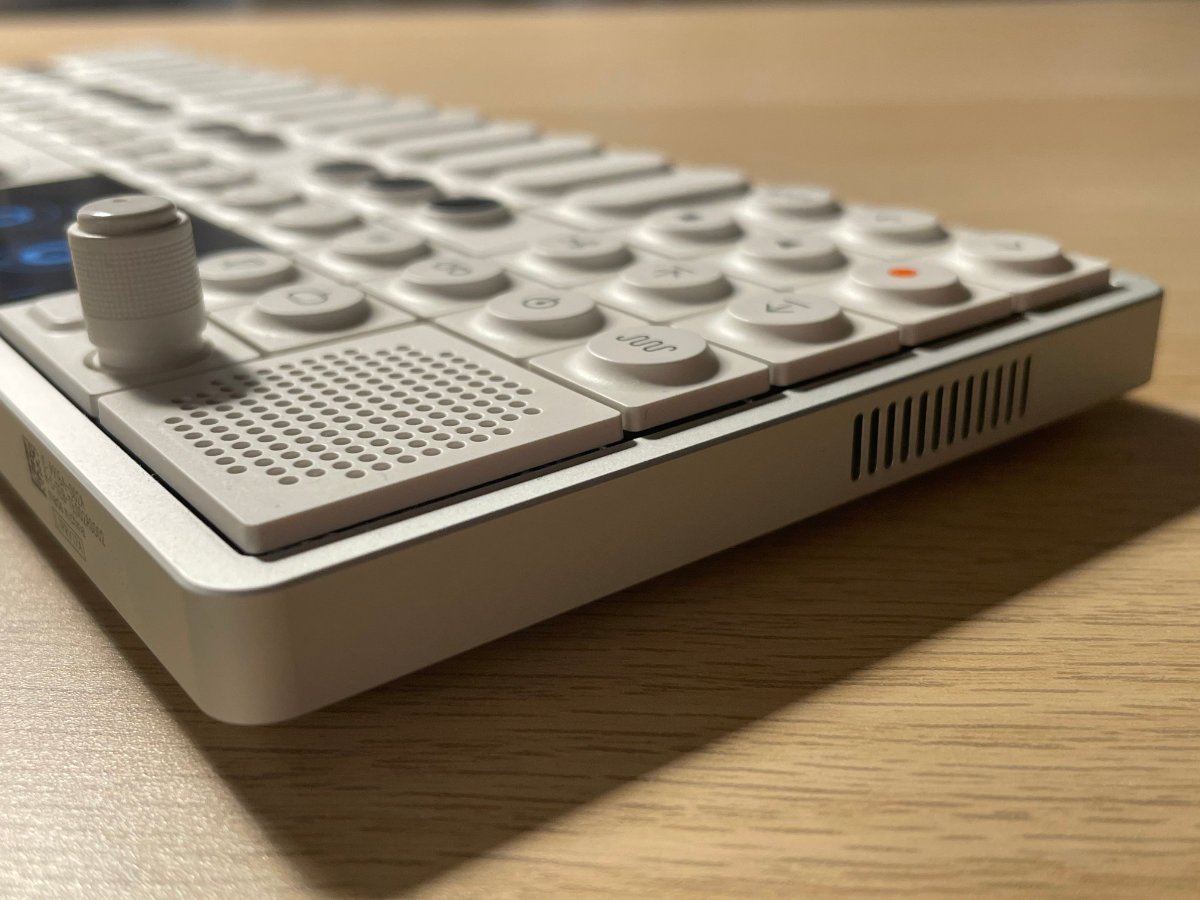
Photo: magazin Mehatronika
As a final point before we move onto a deep dive into the various aspects of the OP-1, we’d like to mention the screen in a bit more detail. See, the original display was an OLED one, which lent itself very well to the vibrant vector-like graphics of the original OP-1. The field has a much higher resolution screen, which does allow for some impressive new detail where it was desperately needed – like in the sampler. The screen is plenty bright and flush with the surface of the instrument, finally, so visibility in direct sunlight and viewing angles have improved considerably. While the display is a quality one, and undeniably an upgrade over the older one, with great contrast and colours, some of the charm of the vector-based look did get lost now that the backlight isn’t perfectly pitch black anymore.
Synth engines
As of the time of writing, the OP-1 field features 13 synth engines. 11 of these have been brought over from the original OP-1 (cluster, digital, dna, dr. wave, dsynth, fm, phase, pulse, sampler, string and voltage) and 2 have been tailor-made for the new model (dimension and vocoder). Some of these engines will be familiar to OP-Z users as their simplified variants make an appearance there.
Each synth engine has four parameter pages accessible using the 1-4 track buttons. The first page houses four (and occasionally more) essential parameters unique to each engine (most of the OP-Z’s engine simplification stems from its two-parameter control scheme). The second page is dedicated to envelope controls, while the third and fourth page are essentially effect and LFO slots, respectively.
These screens are organised logically based on the emulated signal flow — all sounds get synthesised by the engine before passing through the envelope and effect slots, with some parameters being controlled by the LFO. This intuitive layout feels great to use, and takes next to no time to learn (and if you need a quick refresher, hitting the help key brings up little pictograms for easier navigation).
Each synth engine comes preloaded with patches (or samples, in the case of the sampler), but user-created patches can also be saved, as well as transferred via USB-C as single files or packs.
Let’s begin the dive by taking a look at the engines themselves! As with the OP-Z review, these are our own findings and may or may not be quite right (or right at all, as it’s pretty difficult deconstructing some of these) — nevertheless, they should give you some idea of how these engines work. We’ve also prepared some sound examples in the form of short music phrases, meant to capture the general “feel” of each of these engines.
If you’re not interested in our analytical breakdown of each of the engines, you can also skip past these.
Cluster

Photo: teenage engineering
Cluster is an engine which utilises several detuned oscillators (quite similar, unsurprisingly, to the cluster engine on the OP-Z) to make interesting sounds. Unlike the OP-Z, however, we have four control knobs here: waves, wave env, spread and unitor.
The (really dark) blue encoder controls the number of oscillators, which can be set between one and six. It seems some output limiting is present here as there isn’t really any volume difference between a single oscillator and all six of them.
The ochre knob controls the “wave envelope”, which to us sounds like an enveloped low-pass filter. Like many other parameters on the OP-1, this one affects multiple aspects of the sound in complex ways. This knob affects the attack and decay of the envelope controlling filter cutoff. There might be some filter resonance, too, as its sweeps produce a series of overtones.
As opposed to the wave envelope, spread and unitor, controlled by the grey and red knobs, are tied to the same aspect of the engine: the detuning. Unlike traditional detuning which spreads the frequencies of some voices apart, creating a richer sound, cluster seems to set the voices’ pitches into motion, with spread controlling the end points of this movement and unitor controlling its randomness (or perhaps the depth of sample-and-hold modulation, if there’s no random number generation involved) and speed.
Basically — with unitor set to 0, after a while, all the voices settle on the same pitch (which depends on the setting of the spread parameter). However, as unitor value is increased, the motion gets more and more chaotic — and it goes without saying that separate waves have separate paths to take (resulting in sounds which can best be described as “insect swarm” at high unitor values).
This approach to detuning is novel, as this constant movement produces complex interaction between voices which lends itself well to gritty basses and unison leads. Completely closing the filter (by setting ochre at 99) produces a soft sine, great for leads with an ethereal and icy quality, windy noises, or detuned choral pads.
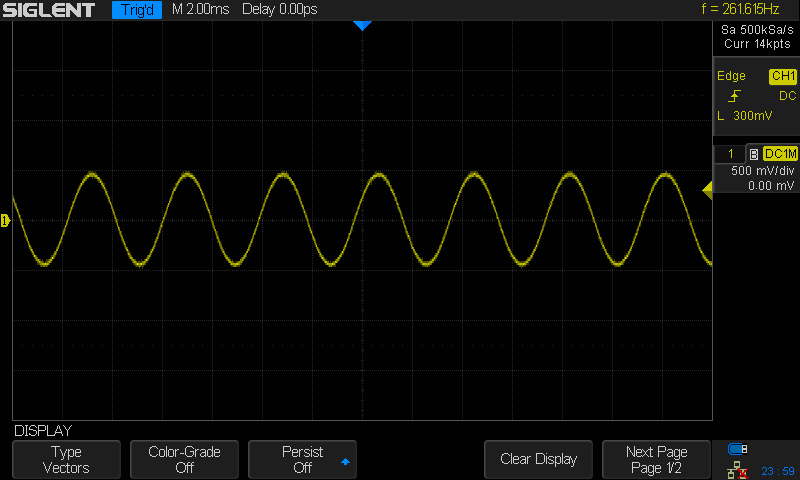 | 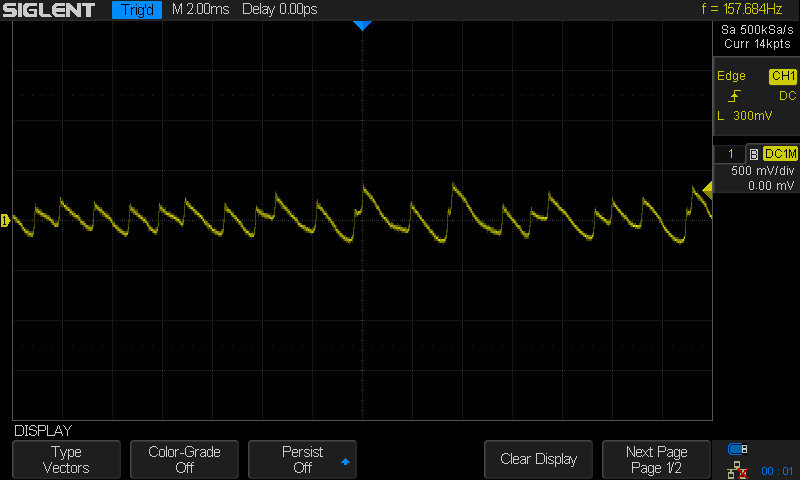 |
| The cluster engine can produce pure sine waves. | But its true potential lies in the creative and chaotic detuning options. |
Digital

Photo: teenage engineering
Another synth which also made an appearance on the OP-Z, digital is somewhat simpler to understand this time around thanks to its extended control scheme.
The blue knob controls the general wave shape, which starts off as a slightly toothy sine wave and progresses into a sawtooth-like wave as the knob gets turned clockwise, before having more and more digital distortion and noise mixed into the signal.
Ochre controls the sub-oscillator’s octave. When set to 3 (which is the “centre position”), the main oscillator and the sub-oscillator are in unison, and other settings from 0 to 6 transpose the sub-oscillator up to three octaves above or below.
Grey controls sub-oscillator detuning and ring modulation between the main and sub-oscillator. With this knob set to 49, we get practically no detuning and no ring modulation. Values lower than 49 pitch-down the sub-oscillator, while values above 50 introduce modulation and raise the pitch of this oscillator, seemingly taking the dry sub signal completely out of the mix and using it only as a modulation operator.
The red knob introduces digital noise into the mix, which also adds significant high harmonics to the signal. This leads us to believe that red is not simply controlling the volume of noise in the mix, but rather a resonant low-pass filter, behind which there is a digital noise source. Additionally, this noise seems to be somehow modulated, with some sort of sample-and-hold in place which determines the exact noise, as repeated notes have subtle differences in their harmonics and wave shape. Finally, there seems to be some wavefolding, as well, instead of simple clipping or limiting, which allows the synth to be driven to much harsher extremes than expected.
There are some weird behaviours, however, which throw us off a bit and which can only be explained by a complex interaction between ochre, grey and red parameters.
First off, it seems that the blue knob has several in-between positions which slightly affect the overtones before the octave change.
Secondly, the ring modulation is weird overall. There’s not that much of a recognisable ring-mod shape when the signal is viewed under a scope, and the depth seems also somewhat influenced by the amount of digital noise introduced by the red knob. Ring modulation becomes way more complex to accurately detect once funkier oscillators make an appearance, so that’s something to remember, too. There seems to be complex interplay between ochre, grey and red parameters which all contribute to the exact method of modulation happening.
Digital is a very fun engine, great at gritty, various leads and basses and intricate, sculpted sounds. While pads are definitely doable, it’s not the synth’s sweet spot.
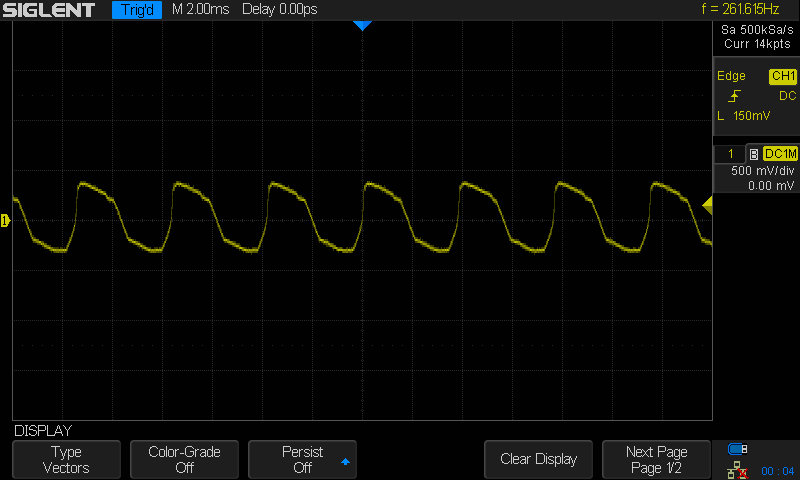 | 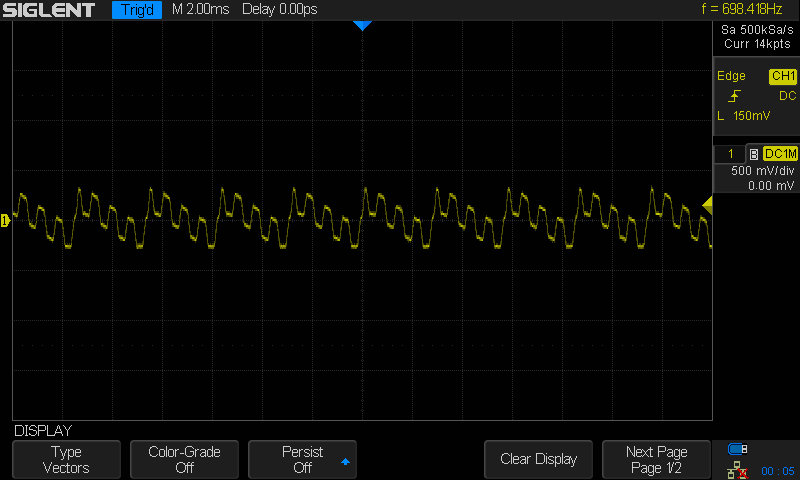 |
| Digital’s initial wave shapes are already somewhat unique. | Digital features a highly resonant filter and interesting modulation options. |
Dimension

Photo: teenage engineering
Dimension is a new synth which debuted on the OP-1 field and (finally) fills the spot of a true virtual analog engine. It’s somewhat more straightforward in design than the previous two engines, which isn’t necessarily a bad thing. Dimension, at its core, is a subtractive single-oscillator synth with a versatile sound. Yet again, there’s four things to tweak.
The blue knob controls the wave shape, nominally starting at a pulse wave with some ringing, then smoothly morphing into a proper square wave (interestingly, some DC offset is present on the pulse wave, which then disappears with the square). This square wave then slowly morphs into a sawtooth wave, and then a sawtooth with a sub-oscillator an octave lower (which sadly cannot be detuned or modulated). Finally, both ends of the spectrum introduce simple grey noise to the signal. This is as simple as it gets — and the UI clearly shows the waveforms selected — which is a nice contrast to the rest of the system.
The ochre knob controls “stereo”, which to us sounds most like a chorus or an odd phaser effect. The knob seems to be controlling both the amount, as well as the stereo width and the frequency of the stereo “beating” which the effect also introduces. A bit weird to see an effect built right into the engine, but with all the jazz about the engines being stereo by default (and the awesome way it sounds: this is a quality chorus effect), it’s a welcome addition and an easy way to get a massive feel out of a relatively simple patch.
The next two knobs, grey and red, control simple low-pass filter parameters. The former controls the cutoff, while the latter controls the resonance. The filter sounds pretty good, and is capable of some fun self-oscillation, but nothing as extreme as some actual analog filters (again, it’s virtual analog we’re working with here). Still, it’s here for basic sound-shaping, and as such, is more than good enough for taking the edge off the general signal.
While it doesn’t sound incredibly exciting on its own, Dimension truly comes to life as part of the entire toolchain, with effects and LFOs in the signal chain. Being the first custom-built engine for the OP-1 field, it was made with the new stereo 32-bit workflow in mind, which does give it incredible audio fidelity. Paired with the OP-1’s quirky and playful set of effects, the engine is capable of some classic, warm analog synth pads, soaring leads and huge basses, but also of massively quirky sci-fi noises. Quintessentially retro, Dimension is the brooding, suave and plush virtual analog that the OP-1 always needed in its arsenal.
 |  |
| The initial wave shape can fall somewhere between a sine, saw and square wave. | Being a true virtual analog, Dimension features an extremely powerful self-oscillating filter. |
DNA

Photo: teenage engineering
Back to the original roster of synths, we have DNA. This engine is extremely odd, and perhaps the most unconventional of the bunch. According to teenage engineering, DNA uses each OP-1’s CPU serial number as a unique seed to feed into its algorithm, producing a unique sound on every unit. This uniqueness makes it quite difficult to accurately figure out just what’s going on in here, but we’ll make our best guess — this is the least sure we are in this entire article.
The DNA synth seems to be some sort of rhythmic noise synthesiser, using the seed as a basis for the noise source itself.
The blue knob controls a low-pass filter, which is the simplest parameter here. Fully closed, the rhythmic pattern can be heard very clearly, while when fully open, the synth descends into noisy chaos.
The ochre parameter controls this rhythmic beating of the synth itself. Presuming that the seed affects this aspect, and given that turning ochre affects the rhythm in very unpredictable ways, it could be that it’s layering on additional oscillators and passing them through some weird subtractive process (which would explain why the signal becomes more and more clean as the knob is turned counterclockwise). This isn’t the best explanation, but there’s definitely some wave layering, as when ochre is turned fully counterclockwise, grey can be used to detune a secondary oscillator.
As mentioned, grey is a detune knob for the secondary oscillator(s?). Checking on an oscilloscope, we can see that sometimes there’s no change to the waveform itself except the detuning, but that sometimes there is quite a large change when this parameter is tweaked. Coupled with the fact that the rhythmic aspect of the sound changes on the same patch across the range of the keyboard, which doesn’t happen when ochre is turned all the way counterclockwise (presumably, the lowest number of oscillators available), there seems to be some intricate modulative interplay between waves which are inherently detuned or even static (controlled by the grey knob) and the main noise source, which somewhat follows the keyboard.
Finally, the red parameter can be used to add some more crunchy noise atop the madness which is already happening. This seems to be a simple volume control for the source, but at this point, we wouldn’t bet on it.
So, to sum up the rambling: it seems that several seeded noise sources are being filtered through a low-pass filter, themselves modulating one another to produce rhythmic patterns, with one (or more) of these following the keyboard while the others follow the grey knob; all of that with some hearty noise on top.
Or we might be completely wrong here. Either way, DNA is a crazy engine which is surprisingly melodic at times, especially for leads (good luck making sounds which work polyphonically), but it requires serious tweaking and heavy effects use further down the OP-1 signal chain. Where it shines is rhythmic textures and percussion-type sounds, where you can get some truly unique, wavetable-like noises out of it. It’s a weird engine and we love it for that, but it probably isn’t the most versatile on the system has to offer.
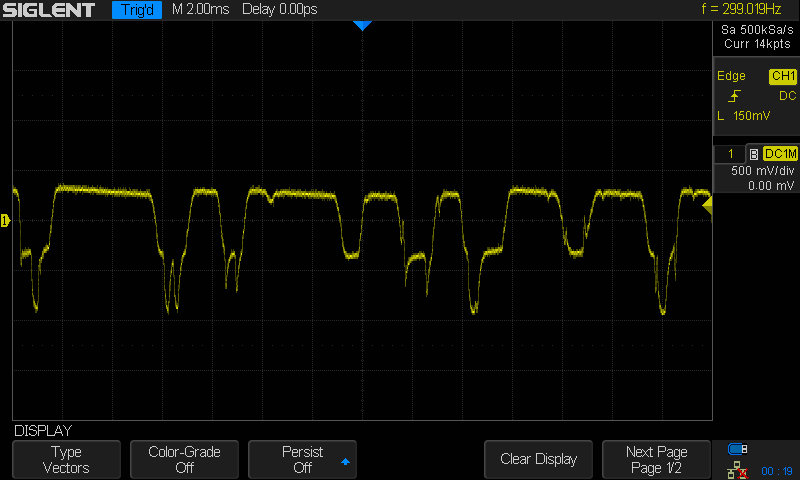 |  |
| DNA’s signal is absolutely crazy: there’s so much going on here that it’s hard to truly figure it out. | Even more craziness inbound here, too… |
Dr. Wave
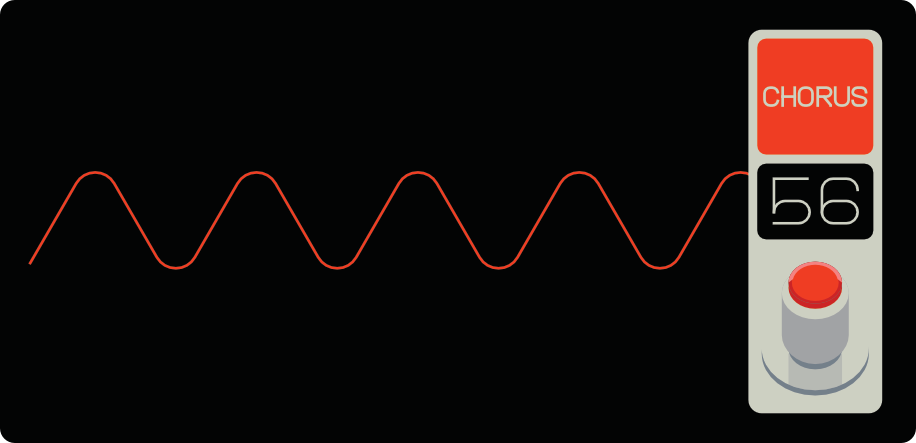
Photo: teenage engineering
Dr. Wave is a staple of the OP-1, probably being the most sonically diverse synth. Despite its intuitiveness, there’s a whole lot of interesting stuff which goes on here, too, as is standard for the entire instrument. Before we try to figure out what the internal architecture here is, let’s start by deciphering what each knob actually does to the sound.
The blue knob controls wave shape and sample rate. As blue is rotated clockwise from its zero position, the wave smoothly transitions between a saw, square and triangle wave. Past this point, the same waves loop again but with some downsampling introduced to the mix. We have reason to believe that this happens post-filter, since looking at the waveform on an oscilloscope, there definitely seems to be some processing of the filter output, too.
The ochre knob controls the filter, which is both a high-pass and a low-pass filter, albeit with fixed resonance. As the filter is turned up from its zero position, it goes into high-pass mode and closes almost fully around the midway point. Right after that, as the parameter is further tweaked clockwise, the filter jumps into low-pass mode and starts off fully closed, before opening up all the way, before the whole parameter set warps around again.
Now comes the fun one: phase. Phase seems to be some sort of resampling algorithm which produces an effect similar to either pulse-width modulation or oscillator syncing, but visually (and aurally) it sounds somewhat different. When this knob is rotated counterclockwise from its “neutral” midway point, the oscillation, which nominally takes up the entirety of each period, gets progressively more and more “squished” to the beginning of each period, producing a PWM-like effect which brings out high harmonics. It’s distinct from conventional PWM, though, as it again happens post-filter (but pre-downsample), as an additional step in sound synthesis before output. What’s going on in here can be imagined as a resampling step, where the created waveform gets sampled and then played back at speeds higher than nominal, with the rest of the period being filled with silence, which causes the active signal to shrink in length.
Turning grey clockwise has a similar yet distinct effect. Instead of resampling the signal once, it gets resampled over and over, yet again at a higher speed than nominal. This creates a sound similar to synced oscillators, but without any waveform distortion which would come from this method. The sound is rich in overtones yet again, but unmistakably still contains the fundamental and is quite thick in texture.
Red controls chorus, which is significantly different from the classic effect. Chorus here seemingly splits the signal into two copies of itself and modulates the pitch of the copy using a sine LFO, the speed of which is set using this knob. As these two shift in relative tuning, their harmonics interact both destructively and resonantly, producing some lovely beating and bringing out the harmonic series, which is most audible at lower LFO speeds. This chorus is quite unique but fun and capable of some spectacular sounds (keep in mind that this chorus isn’t a stereo one, and its use isn’t in widening the stereo field, but is more of a modulation option).
In conclusion, Dr. Wave seems to take a wave, pass it through a filter, resample it and then downsample it before passing it through a wacky chorus implementation. Due to the large amount of ringing artefacts in pure waves generated by the engine, we feel like these might be additively synthesised from a number of separate sine harmonics, which would explain the inability of the engine to produce clean, sharp signal edges.
Sound-wise, Dr. Wave is delightfully ubiquitous. It works well for fluffy pads, both delicate and anthemic leads, chip-tune emulation and even interesting rhythmic patches. Its digital heart covers all bases in clean, pure sounds but lacks the analog heat for powerful and deep basses and more soundscape-filling pads.
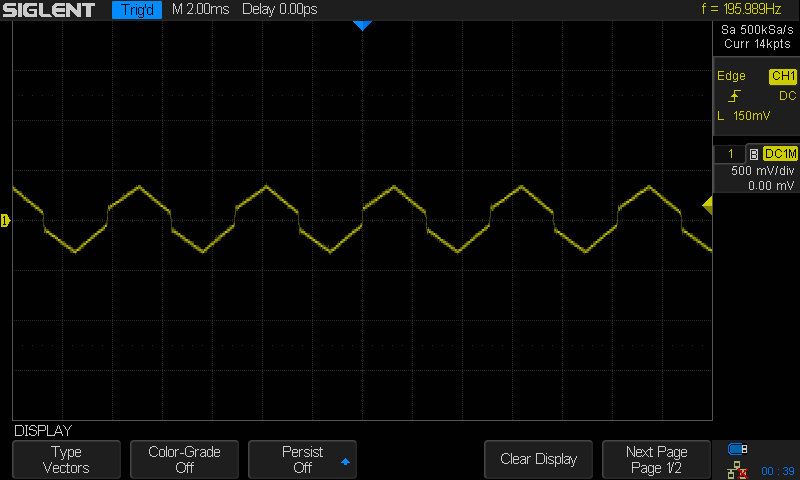 | 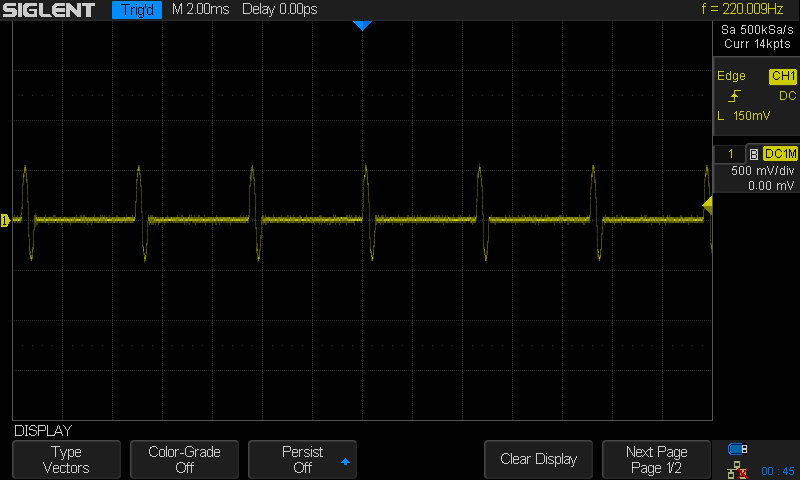 |
| Dr. Wave’s unique approach to synthesis is capable of some complex yet recurring waveforms – no randomness here! | The unique resampling step produces PWM-like effects even with more complicated waveforms. |
Dsynth
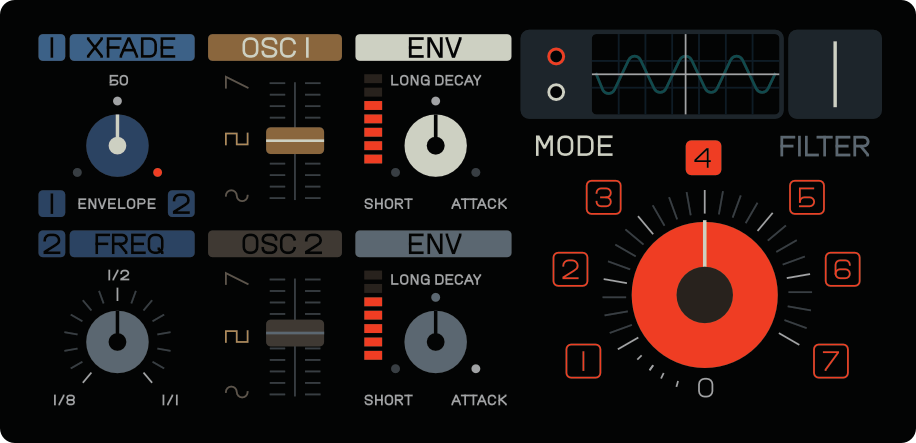
Photo: teenage engineering
Dsynth is another of the old OP-1 synths, and the only one offering eight parameters to tweak. It’s a two-oscillator engine based on cross-modulation and interesting amp envelope control for each of the oscillators, resulting in complex, evolving textures. Since there’s a few more parameters here than usual, let’s break this engine down oscillator-by-oscillator instead of knob-by-knob.
The secondary oscillator has the simpler controls here. “Shift + blue” adjust the frequency compared to the primary, up to four octaves lower. The second parameter, “shift + ochre”, adjusts the wave shape, while the final, shift + grey, adjusts the envelope. This grey parameter is quite quirky, as it works in conjunction with the blue “xfade” parameter of the primary oscillator.
Now, the primary oscillator always tracks the keyboard, so there’s no separate tuning control. Instead, blue here is the aforementioned envelope crossfade parameter. What it basically does is globally affect the shape of envelopes which both of the oscillators’ grey knobs control.
Put simply, the exact envelopes used are selected using the blue “xfade” parameter and the two grey “env” parameters. Sometimes, the crossfade affects the envelopes in such a way that the same values between dialled into the two grey parameters produce different results.
There’s some method to the madness, and compiling a chart is probably possible, but we feel that teenage engineering intentionally obfuscated this part of patch creation to channel people towards sonic exploration, something which we’ve already mentioned is a key part of the OP-1 workflow.
Finally, there are two parameters accessed with the red encoder. “Shift + red” controls a filter, which begins as a low-pass one, which opens up gradually and then becomes a high-pass filter, which eventually cuts almost all sound off when fully turned clockwise. The red encoder on its own controls “mode”, which affects the exact modulation algorithm used. There’s apparently multiple options here, including mixed, unmodulated signals, some FM and AM algorithms, true cross-modulation and some ring-modulation sounding options, too. Anything in-between is also possible.
Dsynth is a cool one. Digital and noisy, it’s capable of lo-fi blips and bloops (makes sense given that it’s a melodic version of the Dbox drum synth) and various sound effects, but also surprisingly clean, musical leads, bouncy chord synths and growling basses. Finally, its complex envelope options offer up a glimpse into the world of evolving pads. Though there’s better synthesis methods for this (and true bi-timbral instruments), the required core functionality is present, which allows for some truly intricate textures.
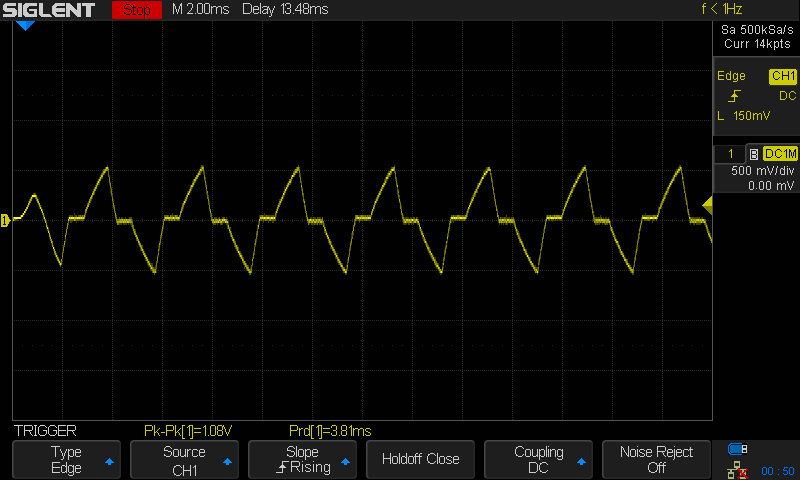 |  |
| This shot was taken at the very beginning of a sound. | The dual-envelope action can be seen here. This shot was taken from the same sound as the first image, just later on: note the non-linear rate in at which different parts of the signal change. |
FM

Photo: teenage engineering
Our favourite engine of the bunch, FM is a lovely four-operator frequency-modulated synth. It’s one of the most rewarding and sonically pleasing of the bunch (in our humble opinion). FM again uses the traditional four-parameter setup, with blue, ochre, grey and red controlling FM amount, operator frequency, topology and detune.
The blue knob affects modulators and carriers differently, changing modulation depth for modulator operators and volume for carrier operators. This effectively introduces more and more high harmonics in unpredictable ways as amount of interplay between these elements increases. When blue is set to 0, only the base operator sounds, producing a pure sine.
Ochre controls the frequencies of the operators. There’s hundreds of sets of frequencies which can be chosen, represented as ratios or multiples of the base operator’s frequency (which is key-tracked). This isn’t the sleekest method of inputting frequencies (maybe a “shift + encoder” method, like with Dsynth, would allow for individual addressing of operators). Still, this design decision is in the spirit of the OP-1: forcing tweaking and exploration and not quick and concise sound creation.
Grey controls the topology. This is pretty self-explanatory and is well represented by the UI, with the signal flowing left-to-right. To us it seems that cubes arranged in a diagonal “top-left to bottom-right” fashion are always modulator-carrier, while cubes arranged in a diagonal “bottom-left to top-right” fashion are simply mixed together.
The topologies are overall a good mix. There’s eight of them, from fully parallel ones to chained ones and everything in-between. It’s worth noting that some of these probably feature some self-modulation of certain operators (otherwise topology 8, which is fully parallel according to our findings, wouldn’t change timbre so drastically due to blue parameter use).
Finally, red is an interesting detune option. Best analysed with topology 8 (the parallel one) and blue set to a low amount, it only detunes three of the operators, leaving the base frequency in place. When fully turned up, the voices can wander off up to a major third from their nominal pitch. Interestingly enough, red also adds a level of LFO pitch modulation which runs at different frequencies on each of the three detuned oscillators, adding a lot of beating and rhythmic texture to the sound.
FM is good for basically every type of sound imaginable. While FM synthesis in general is notorious for being somewhat hard to grasp, and while it’s relatively easy to end up with discordant cacophony (but then, maybe that’s what’s desired at times), when its sweet spot is hit, this engine provides some of the lushest, most intriguing and timbrally rich sounds. From complex bells with series and series of overtones to lush, warm pads and amazingly heartfelt basses and leads, this synth delivers. Some of the sweetest sounds imaginable can be produced with the same technique which can produce some of the nastiest growling. That’s the magic of FM synthesis!
 | 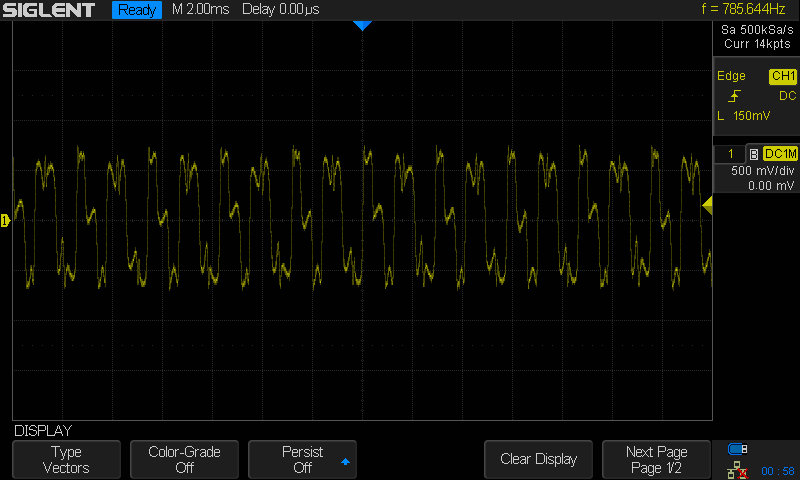 |
| Complex signals typical of FM synthesis are, naturally, easy to achieve. | More ringing and clanging can be brought to the sound when more dissonant frequency ratios are used. |
Phase

Photo: teenage engineering
Phase is a phase distortion synthesiser. Phase distortion, as a technique, is vaguely similar to frequency modulation, but also has some significant differences. Championed by Casio in the mid-80s as a response to Yamaha’s range of legendary FM synths of the time, it uses some clever math to model complex and rich sounds. Without getting into too much detail and general theory about this synthesis method, let’s run over what the four parameters do here.
Blue and ochre encoders control the phase distortion itself. In grossly oversimplified terms, this type of synthesis is yet again based on a sort of “resampling”, like in Dr. Wave, but this time this sampling happens at a variable rate during each cycle. Initial implementations of this method used a pair of line segments to control this, but it seems that teenage engineering is using something a bit more complex here as the source of this variable speed counter. What this results in are smooth waves with surprising, sudden changes in frequency which happen every cycle, resulting in timbral, rather than pitch changes.
The next two knobs, grey and red, control a highly resonant filter, which sounds most like a band-pass one. This filter, at least to us, seems like a modern implementation of Casio’s original resonant filter as found on their old phase distortion-based synths, which achieves its complex overtones by using a pair of hard-synced frequency counters running at slightly different rates to control the sample speed of the wave produced by the oscillators. In a sense, the filter uses more or less the same process as the initial signal generation itself.
In this case, grey controls something which sounds most like resonance, but doesn’t exactly read out as such on a spectral analyser. What this parameter really does, judging by our oscilloscope’s readout, is apply a cyclic amp envelope which goes from a straight line (or better said, no envelope applied) to a downwards ramp each cycle. This effectively creates a somewhat similar change in signal to what a resonance knob would do, but with noticeably different overtone makeup and timbre.
Red controls the band of the filter. We think that this parameter controls the exact speeds at which the frequency counters run, thus modelling a band-pass filter, but we aren’t exactly sure on the specifics here. It seems that higher values of red affect the exact slope at which the variable-rate resampling speeds up, thus squishing the signal in a PWM-esque way. The final waveform looks very similar to the output of the aforementioned legacy Casio one, so we’re mostly sure that this is what’s happening.
Phase is a smooth-sounding engine overall, with a rich tone (albeit perhaps not as rich as FM) and the same capability for highly dissonant and aggressive patches as the former. Compared to FM’s ever-bubbly texture, Phase has a much more traditional, linear sound which still differs from classic additive and subtractive synths. It simply works for all kinds of patches. Perhaps more suited to concrete leads and basses than dreamy pads, Phase is built atop a nowadays rarely-seen 80s technology and is a breath of fresh-old air.
 | 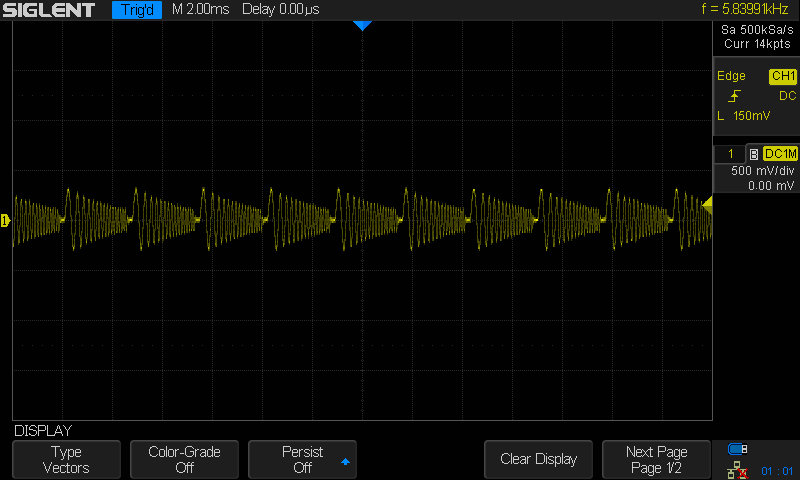 |
| Some Dr. Wave-like behaviour can be seen here, too, albeit with a variable resample rate, which has an obvious “knee”. | The envelope which grey controls can be seen in action here. |
Pulse

Photo: teenage engineering
Another of the simpler engines, Pulse is a dual-oscillator synth which builds its waveform using, as the name suggests, a pair of pulses. These two pulses can be brought closer together or spread further apart, after which the signal goes through a filter and optional modulation is applied.
Blue controls the low-pass filter. This is a simple enough parameter, but there’s a twist, as it seems that every note has a bit of a downward filter sweep at the start. The envelope affecting this also seems to be key-tracked as sweep times seem to differ across different octaves. This behaviour gives each note a bit of an initial punch, as unfiltered pulses are rich in higher, odd harmonics.
Ochre controls the amplitude. This is a relatively simple parameter which mostly affects the loudness of the overall signal. There seems to be some boost to higher harmonics in the signal at high values here, which might be due to some internal peaking or clipping.
Grey controls the spacing between the two pulses. They morph into a single one when this is turned all the way counterclockwise, and are equally spaced when it’s turned fully clockwise (the resulting sound being an octave higher, for obvious reasons). This sounds most like a PWM synth, but with some really interesting twists in timbre. It’s definitely a novel parameter to have control of.
Finally, we have the red modulation parameter. When turned counterclockwise, it uses an LFO to control the grey parameter, shaking the secondary pulse around, adding flutter and movement to the sound. When turned clockwise, we aren’t as sure, but there seems to be some AM going on, with the LFO eventually reaching audio frequencies, as a series of overtones can be heard — or at least that’s what we think is going on.
Pulse is a bit of a blander synth which we feel is more of a utility which covers some missing waveforms. At least in our opinion, it gets most of its character from the OP-1’s amazing set of effects which get applied further down the signal chain. Still, it’s a perfectly good synth with great audio quality, but it just pales in comparison to its wackier, bolder brethren.
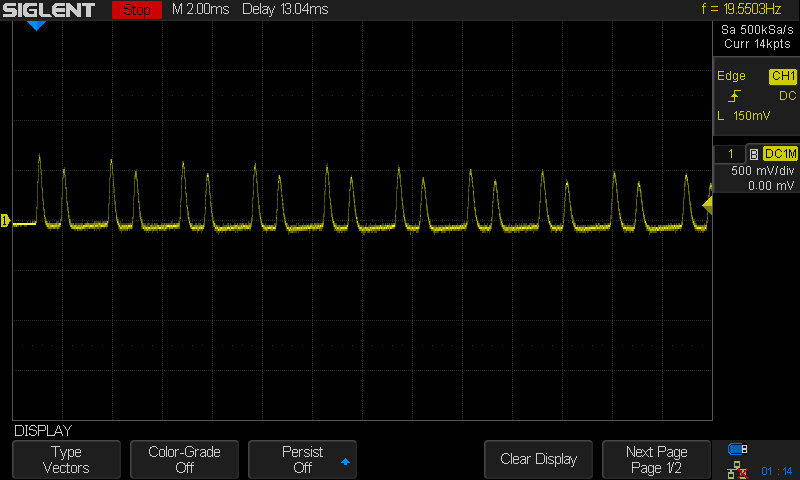 | 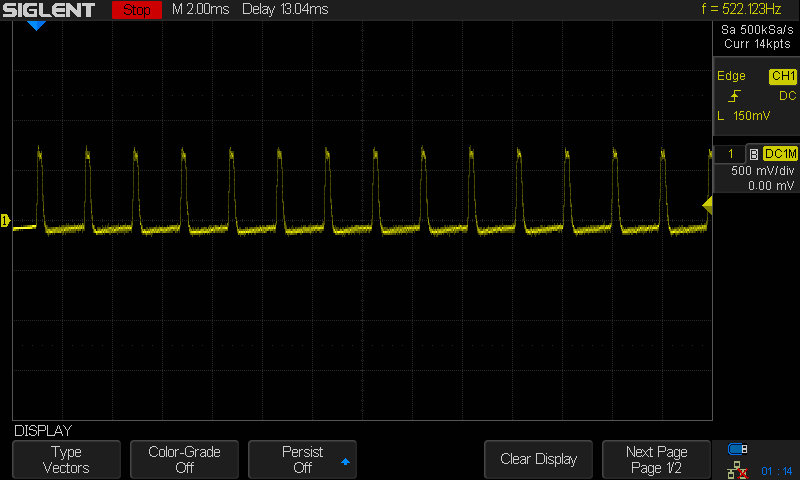 |
| Two pulse peaks, after the initial filter sweep. | Pulse’s signal right as the sound gets produced, pre-sweep, showing a more rough edge and thus, a more open low-pass filter. |
Sampler

Photo: teenage engineering
The sampler isn’t a generative synth engine per se, but it’s a cornerstone of the OP-1 workflow. We’ll just quickly skim through it, as it isn’t as confusing as the other engines and offers very hands-on control.
Basically, it takes a sample which can be recorded with the built-in mic, taken from the radio, sampled from OP-1’s own tape, via USB audio, or using the line input; then it allows for precise editing of the waveform start and end points, as well as selecting the sustained part of the sound, which loops with a crossfade. This crossfade can be adjusted, as well as general gain, tuning and playback direction.
This is a simplistic approach, but there seems to be some algorithm magic going on in the background because this is one of the best single-sample samplers we’ve ever heard. It just sounds good, with no graininess or other digital distortion caused by pitch shifting. The high-quality mic in the OP-1 field also plays a huge part here, as it’s probably the most common way people sample things.
Many people consider the OP-1 to be a sampler first and synth second, and while that isn’t fair to all of the wonderful synth engines packed in here, there’s something charming about such a simple-yet-good-sounding and versatile sampling system (so many sample sources are available). The portability also allows for taking the OP-1 field out into the… field (ha, get it), which opens up a whole world of creativity waiting to be turned into a playable instrument.
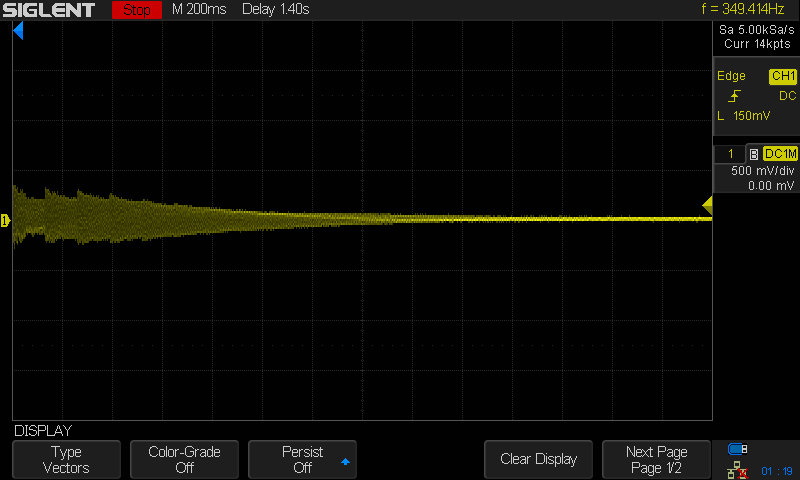 |
| A piano sample, as played by the sampler, with a delay effect in the chain. |
String

Photo: teenage engineering
String is perhaps the most inherently melodic of all the synth engines, capable of creating rather organic sounds. To us, it sounds like a Karplus-Strong engine, somewhat similar in character to the one used in the OP-Z’s Bow engine.
Karplus-Strong synthesis is one of the first physical modelling ones, approximating the vibration of a string by establishing a delayed feedback loop, with a noise source at the start, applying a non-resonant low-pass filter which closes more each time the loop repeats (a resonant filter would, logically, add an undesired overtone sweep, something which real-world strings aren’t exactly known for doing), emulating the gradual decay much better than an amp envelope would. Of course, we skimmed over some of the details here, but in essence, this simple algorithm models the behaviour of a physical string quite well.
Being a physical modelling engine, String doesn’t offer parameters which translate readily into more traditional synthesis terms (though, same can be said about many of the OP-1’s engines), but rather terminology which applies much more to a plucked or struck string instrument: we have tension, impulse, detune and impulse type mapped to blue, ochre, grey, and red.
Like we just mentioned, blue controls the string tension. As this encoder gets turned clockwise, the strings get “tightened”, which shortens the decay and makes the sound duller. This is achieved by steepening the low-pass filter slope (and also, perhaps, by starting the entire process with the filter partially closed). Aside from making the sound duller, there’s a bit of a detune going on at the far clockwise end, as well as a volume reduction, due to the non-resonant nature of the filter.
Ochre controls impulse, or the amount of energy “introduced” to the string in the model. In our case, it’s controlling a volume envelope applied to the initial sample. The more clockwise this encoder gets turned, the slower this downward envelope sweep is, resulting in more of the original signal, that is, the noise, coming through. It primarily affects timbre, but also volume, simply increasing the initial volume of sound before the filtering steps.
The next parameter, detune, is a bit inaptly named. We think it controls phasing, a bit similar to what Pulse does with its grey knob. This phasing is achieved by copying the signal and then horizontally shifting one of these copies, introducing interesting additive and subtractive artefacts to the sound, bringing out certain and cancelling out other harmonics. Turned fully clockwise, the signals seem to be exactly half a period out of phase, as the fundamental gets cancelled out, leaving a fluffier sound, sounding much like a pizzicato flageolet of a bowed instrument.
Finally, red controls impulse type. Meant to model various excitation sources, it aims to achieve this by running the noise source itself through a low-pass filter before any further synthesis steps are taken. This filter opens up as the knob is turned clockwise, making the entire final patch more resonant and bright. There’s not much more to this — and the action of red can be heard very clearly with all other parameters turned fully clockwise.
String is very melodic and human, great for emulating a wide range of string instruments. Coupled with some of the OP-1’s effects, it’s a genuinely heartfelt instrument, perfect for soft basses and dreamy, melodic lines.
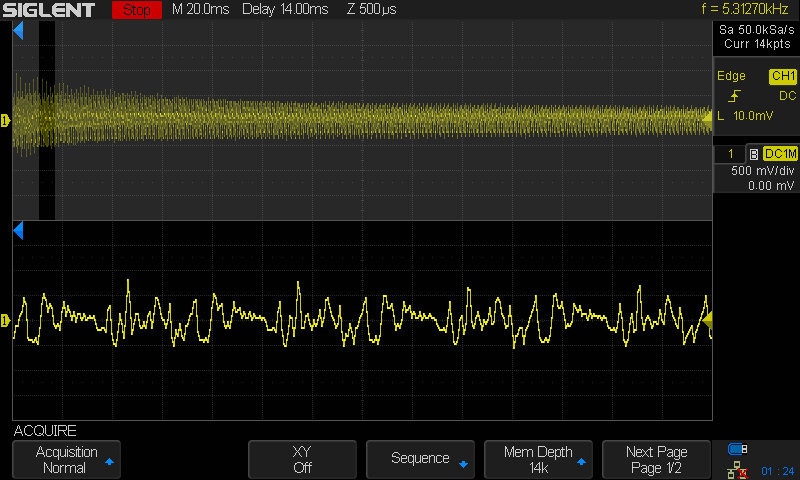 |  |
| A long sustained note produced by the String engine, showing the unfiltered signal from the beginning of the note duration. | Characterising filtering action can be seen as the string decay gets simulated, characteristic of Karplus-Strong synthesis. |
Vocoder
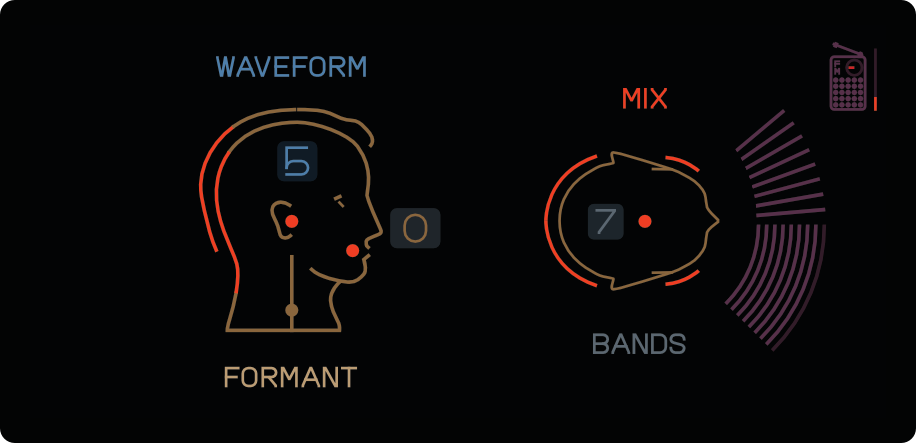
Photo: teenage engineering
The vocoder engine is exclusive to the OP-1 field, just like Dimension. Unlike Dimension, however, it wasn’t available at launch, but was added via a later software update.
Vocoding is a simple technique: a carrier waveform gets passed through a series of band-pass filters (simply called “bands”) which have their volume modulated by the loudness of the very same bands in an analysed audio sample, thus imbuing some of the timbral properties into the carrier waveform, while keeping the pitch static. For more complex sounds, like words, to be recognisable, the carrier wave has to be sufficiently rich in harmonics and there has to be enough bands to accurately model speech.
This is one of the more straightforward engines, thankfully, but a fully-featured vocoder nevertheless. Four parameters, as usual: waveform, formant, bands and mix mapped to the four colours.
Blue is essentially all the control you get over the carrier wave. Fully counterclockwise this carrier is an interesting mix between a sine and pulse wave. As the knob gets turned clockwise, noise and some phasing seems to be added to the mix, introducing more complex harmonics, until finally, only white noise remains.
Ochre controls formant shift, which essentially moves around the frequencies at which the filter bands sit. This changes the tone of the vocoder and also the perceived voice depth.
Grey controls the number of bands. The more filter bands there are, the more details get transferred to the final sound. The OP-1 field’s vocoder can have between zero and seven bands.
Red controls the mix of the dry input signal and the vocoded output. Fully counterclockwise, no input is mixed in. When turning the knob clockwise, more and more gets added (watch out for speaker-mic feedback loops).
The best feature of the vocoder is in the versatility of inputs. Anything which the sampler can sample (with the exception of the sound of the OP-1 itself), the vocoder can vocode. This includes the line input, and surprisingly, the radio. In the right hands, this is an immensely powerful and creative tool, and we commend its inclusion.
Voltage

Photo: teenage engineering
Voltage is an interesting take on two sine oscillator AM synthesis. This time around, our parameters are electricity themed: we’re working with amps, volts and ground noise. According to the manual, however, these parameters are way less exciting, controlling modulation amount, ground noise, a filter and a detune option.
The blue knob controls the AM modulation amount. There seems to be nothing too odd happening here, as it simply seems to modulate the primary oscillator with the secondary one, while controlling the mix of the unmodulated and modulated signals.
Ochre controls the amount of “ground noise” added to the second oscillator. It’s distortion mixed with noise, which oddly sounds a lot like ground loop noise (which is probably why it’s called that). The sine wave gets little spikes in its waveform, and then more and more noise as this knob gets turned clockwise. Without modulation, it doesn’t sound terribly exciting, but it truly introduces wonderful timbral complexity when such a wave gets put through AM.
Grey controls a low-pass filter, but its behaviour is a bit more complicated than that. While yes, there’s filtering going on in here, there also seems to be some crossfading action between the modulated signal and the first oscillator’s signal (as opposed to the mixing which blue provides). The filter cutoff also isn’t exactly a linear curve here, as but more of a reverse “V” shape, with it being the most open at the middle region.
Finally, red controls the tuning of the secondary oscillator. Fully counterclockwise, both oscillators are unison, and fully clockwise, the secondary is an octave below. As simple as that!
Voltage is a biting, aggressive synth which does sound a bit like high-voltage sparks at all times. It’s great for harsh leads, but also surprisingly good for some evolving sounds, like all AM synths are, due to the rich harmonic content provided by the generated sidebands. Slow LFO sweeps of the red and blue parameters can truly bring life to some harsher pad-type sounds. Voltage is definitely one of the synths with quite a character.
 | 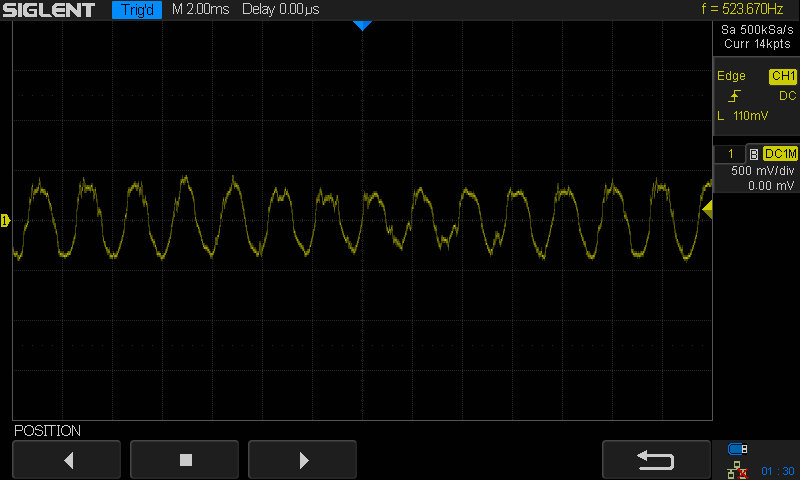 | 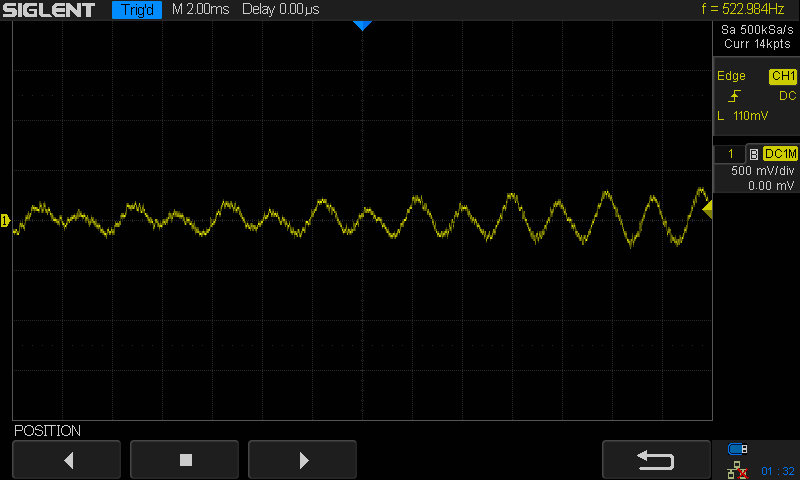 |
| Detuning the sub oscillator and then bringing it back to pitch seems to keep the phase offset caused by the initial detune, as seen here. | With some noise, Voltage’s AM modulation produces some unexpected and interesting results. | With a lot of noise mixed in, Voltage is capable of some gritty and complex sounds. |
Whew! We got through all of the engines now. That was quite the journey. There was a lot of guesswork and also diligent analysis involved, but we think we’ve gotten a lot of it right. Hopefully this chunk of the review sheds some more light onto the inner workings of the OP-1 for both new, old and future owners of the magical little device.
The rest of the signal chain
Synth engines are the most mysterious, but not the only charming part of the OP-1’s signal flow. Just as interesting, albeit much simpler to understand, are the eight effects which can be mixed and matched with the synth engines.
These eight are cwo, delay, grid, mother, nitro, phone, punch and spring. Most of these are pretty standard, but offer some exciting functionality in addition to their basic purpose. Let’s quickly run through the list and leave a few comments on each!
CWO

Photo: teenage engineering
Perhaps the most iconic of the bunch, CWO was designed by Sonic Charge’s Magnus Lidström as an adaptation of the Echobode plugin. It’s essentially a delay effect with an overtone frequency shifter, which affects all overtones linearly, unlike a regular pitch shifter. This creates detuned clanging and noise as the tone gets broken down from the inside. Additionally, two detunes frequencies are created for each harmonic, which can then be crossfaded for even more chaos.
The four parameters here offer simplistic control over delay length, frequency shift amount, dry/wet mix and sideband crossfade.
Delay

Photo: teenage engineering
Delay is a pitch-shifting delay effect. With a quirky control scheme and clever graphics, it packs all the essentials with a few twists. Sure, many standalone VSTs or even hardware delay processors have much more functionality and more robust controls, but there’s undeniable charm in this implementation. Finally, it sounds really good, so there’s not much to complain about here.
Grid

Photo: teenage engineering
Grid is yet another delay effect, focused on modulation and distortion rather than just pitch shifting. With self-oscillation capabilities, it’s quite a powerful effect which can add some quirky trails to note or fully distort the entire soundscape.
Mother

Photo: teenage engineering
Mother is a classic gated reverb exclusive to the OP-1 field — as weird as that sounds. As is customary, quirky graphics dominate the interface, this time depicting a child calling its mother, with the sound bouncing off a wall. Mother is a rich effect with great sound quality, precise control over timbre, distance, decay and gating and a warm tone. It pairs perfectly with the Dimension engine, but also many older ones, and is the “standard” reverb that the OP-1 lacked.
Nitro

Photo: teenage engineering
Despite looking like an arcade game, Nitro is a no-nonsense dual filter with an envelope follower which affects the cutoff frequencies. Both filters are capable of self-oscillation. Nitro is a great tool to have, and is a powerful filter in general. Sounds good, too, but that’s to be expected from teenage engineering.
Phone

Photo: teenage engineering
Phone is a fun granular glitch effect. Mimicking a satellite phone, it uses telecom terminology to present its unique feature set. What Phone does it relatively simple: it chops the signal up into many tiny “grains”, and then pitches them up or down, with a varying degree of repetition of individual granules. Various effects are achievable like this, from a simple detune to truly crazy broken-phone-line sounds which completely morph the original texture.
Granular effects aren’t the most common, so they are definitely welcome on a piece of hardware. We just wish there was a granular synthesis engine to go with the effect.
Punch

Photo: teenage engineering
Punch is a resonant low-pass filter with an adjustable slope. It’s capable self-oscillation. Compared to Nitro, which is much more suited for more dynamic sounds, Punch is intended to be used as a standard low-pass filter, great for taking the edge off of harsher sounds and rounding off aggressive pulses.
It’s a great tool to have, and is one of the most commonly used effects on the OP-1 when traditional sounds are required.
Spring

Photo: teenage engineering
The original reverb of the OP-1, Spring is a relatively clean digital effect. Offering space size, tone, decay and wet/dry mix controls, it’s fully featured. However, its sound signature is much different than that of the Mother, being notably less plush and deep, and tending to sound rather metallic and even distorted at times.
It definitely has a character, and being the only reverb of the original OP-1, its unique sound signature made its way into many pieces produced on it. It’s iconic and has a place, but isn’t quite fit for every genre.
———
Aside from the effects and engines, the core signal chain also contains an envelope and an LFO. The envelope is a classic ADSR one, and is also the place where some performance controls live, like mono/poly/legato/unison settings, portamento, pitch bend ranges and general patch volume.
The LFO is where additional modulation options live. There’s six modes: element, midi, random, tremolo, value and velocity. Even though all of these fall under the overarching “LFO” category, some options work much more like an envelope, or fall somewhere in-between.
Element
Element isn’t an LFO in the standard sense, but more of a powerful envelope which can take some unconventional input sources. Element is capable of modulating each and every parameter of the main ADSR envelope, all of the synth engines and all of the effects, as well as some general parameters, like pitch and volume (this is true for basically all of the LFOs). As its modulation source it can utilise the main envelope, as well as the built-in microphone, accelerometer, or an envelope follower listening to the output of the active synth. This offers a lot of creative options, as well as pure utilitarian value.
The main drawback is the ability to only control one parameter at a time. There’s no dual modulation options, and this is something which holds true for most of OP-1’s LFOs.
MIDI
The MIDI LFO requires some external gear capable of sending MIDI CC signals. Annoyingly enough, this is the only of the LFO options which has four parameters it can modulate. Due to its nature, it’s probably best to use this with a DAW, to enable full LFO functionality — but at that point, why work on the OP-1?
That aside, maybe we’re being just a little unfair to it. There’s genuine uses for this LFO, especially when connecting expressive controllers or other outboard gear which controls several CCs at once – it’s extremely useful in this regard. In this case, however, why is it one of the LFO options? This problem is made even worse by the fact that it takes the slot up, so using it severely limits sound design capabilities.
Random
Random is fun. It’s an enveloped LFO which uses a random number generator to modulate parameters. The envelope controls the amount of modulation, so this mode is quite good for evolving pads or otherwise complex sounds. Its speed is also adjustable, both normal and synced to the track tempo.
Tremolo
More of a tremolo effect than an LFO, tremolo modulates two parameters: volume and pitch, but these cannot be changed. There’s control over an envelope and modulation amounts for both of these, as well as normal and synced speed options.
Tremolo is on the fine edge of being between an LFO and an effect. It makes sense why it’s located here, and it’s undeniably a useful tool, but it would be great to see an LFO which has two modulation targets which can be fully selectable. That would open a whole new world of sonic possibilities, something which Tremolo just does not do.
Value
Finally a standard LFO! With selectable wave shape, frequency, sync, modulation amount and target, it’s everything an LFO should be. From filter sweeps to envelope controls, Value is probably what you’ll want to use if you’re going after rhythmic texture in sounds.
Velocity
Velocity uses key velocity information as a modulation source, allowing for more expressive sounds and modelling of classic “e-piano” filtering behaviour. Even though it was around on the original OP-1, the field’s velocity-sensitive keyboard adds a significant amount of utility to the LFO. Additionally, the volume envelope can also be modified, tweaking the velocity curve for a patch.
———
With all of this out of the way, we’ve covered most of the signal chain in detail. Let’s take a glance at what else is around on the OP-1, and take a look at some alternatives and criticism, too.
Some of the remaining tools
We’ve been basing the entirety of the previous section on the synth mode, where most users spend most of their time. However, there’s another sound synthesis mode that’s just as important: drum.
Drum follows the same essential workflow, but with some differences. Most importantly, there are only two engines here: Dbox and a modified sampler. Secondly, the ADSR envelope is replaced with an interesting dynamic envelope, useful for bringing up various points in a sample.
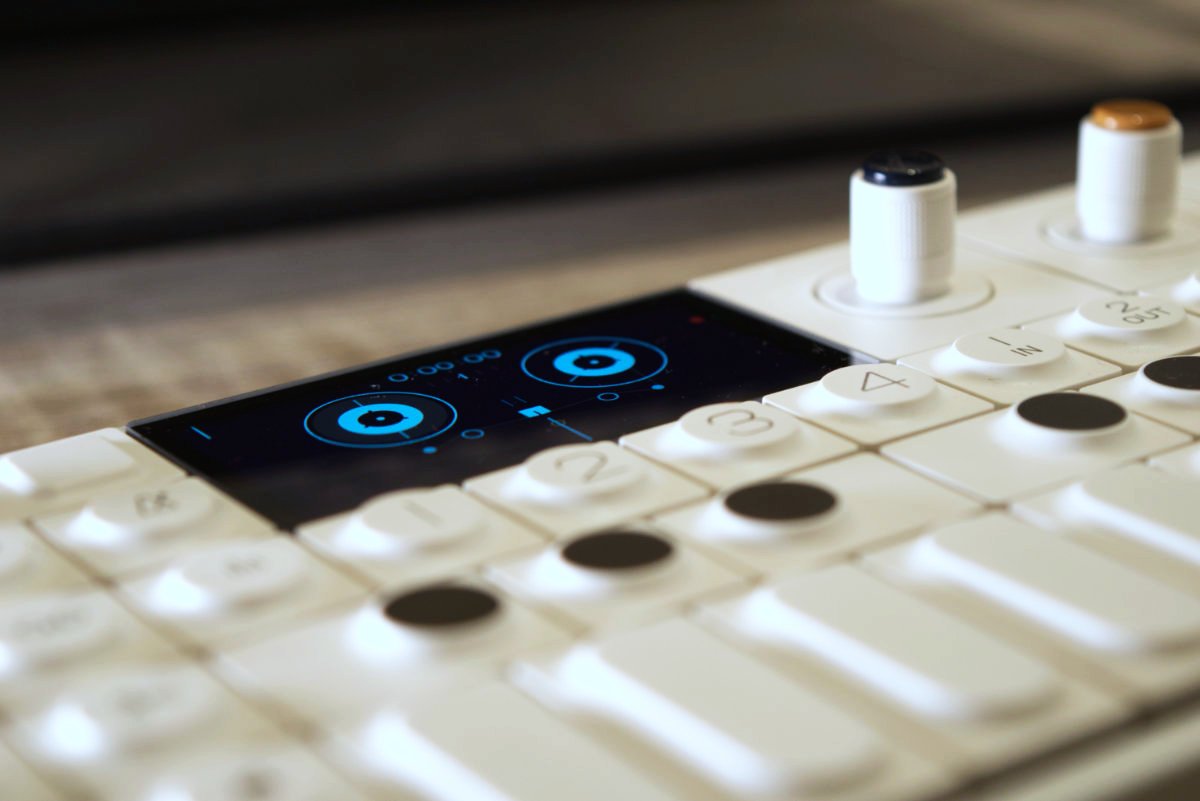
Photo: magazin Mehatronika
Dbox is what Dsynth has been based on, and offers a very similar setup to the latter, with more or less the same signal flow. Of course, it offers per-note settings to enable emulating a full drum kit. A similar difference can be seen with the sampler — instead of pitching a sample up or down, it allows for splicing a longer sample into separate one-shots, triggered by each key.
Let’s move onto the three tools which actually allow for a full track to get made: tape, sequencer and the mixer.
At the heart of the recording workflow lies the four-track tape recorder. Unlike many other modern devices, including the OP-Z, these tracks emulate analog behaviour and thus record audio, and not MIDI. This does make editing takes after recording quite tricky, but that’s the intended workflow here: committing things to tape only once they’re perfected. This also means there are no tools like quantisation either, but there are multiple ways to achieve precise note input using the onboard sequencers or externally synced MIDI gear.
Only having four tracks is another limitation of the tape, making careful and resourceful planning of tracks a necessity. Of course, resampling is a huge part of the workflow here, either by using the sampler itself or by using the “out-in” mode for feeding the final output from the OP-1 right back into it, allowing for three finished tracks to be compressed into the fourth.
Like with old-school tape machines, it’s possible to overdub across already recorded regions, adding little details in, as well as to manually cut bits of tape and paste them elsewhere. Tape regions can be moved around and stitched together, but save for these, there’s not a lot of timing manipulation which can be done. Notably and somewhat infamously, there’s no undo key of any sort. All of this is not to say that precision work isn’t possible. Using sequencers, the tape loop capabilities, splicing and some care, it’s possible to line all the up tracks perfectly.
We almost forgot to mention that the tape can record from any audio source available to the OP-1, including the radio, microphone and line input. How cool is that?
While the tape emulator might sound somewhat limited, there are numerous unique features which make it quite interesting. There are settings for the tape motor speed, which also affects the recording tape speed, there are emulation modes for various physical media: three different kinds of tape and minidisc, each with their own artefacts and sound profile, there’s tape tricks to be used during recording and playback, enabling tape reversal, stuttering, and a simulated motor stop. Scrubbing the tape manually with an encoder or using keys produces a rewind sound of the actual audio that’s being scrubbed over. So much thought and detail went into modelling the tape to work like an actual physical medium, it’s clear that all of the limitations aren’t just arbitrary design choices.
Yeah, eight tracks would be amazing to have, as would advanced DAW-like tools, but there’s something inherently inspiring and hands-on with the retro approach which makes the OP-1 feel that much more organic and natural.
The main mixer is tied to the tape, offering per-track panning and volume, as well as a general three-band equaliser with a spectrum analyser, one global effect slot and one master volume fader with a two-parameter compressor.
Perhaps most importantly, tracks are stereo in the OP-1 field, meaning that any resampled sets of tracks which were panned using the mixer will remain properly panned, allowing for much easier management of projects with a large amount of layers.
Finally, it’s worth mentioning that the OP-1 field can store up to eight projects — tapes — on its internal disk, which is a big step up from only one on the older OP-1.
Finally, there’s seven sequencers onboard, too: arpeggio, endless, finger, hold, pattern, sketch and tombola. Some of these are pretty self-explanatory: arpeggio is a basic arpeggiator, hold is used for sustaining drone notes and pattern is a piano-roll type sequencer. Endless also isn’t too complicated, as it’s basically a very extensive step-sequencer with some interesting sequencing options — and probably the most useful of the bunch.
Finger, sketch and tombola are the stars of the show when it comes to creativity, with finger being a crazy step sequencer pair with a number of pattern slots, sketch being an Etch-A-Sketch emulation which turns art into MIDI, which is particularly fun for drum synthesis (and yes, you shake the OP-1 to erase it — something tell us this is why teenage engineering bothered to include the accelerometer in the first place, and not the element LFO), and tombola simulates a spinning tombola wheel, with notes represented by balls tumbling inside, producing MIDI output when they strike the sides of the wheel or each other.
Tombola is especially remarkable for having tweakable physics, with options for changing ball bounciness and overall gravitational acceleration of the environment. It blends the lines between physical simulation and sequencing, and isn’t just a glorified random sequencer. It’s truly one-of-a-kind.
Still, the whole lineup lacks some of the most powerful sequencing features found on the OP-Z, like pattern chaining, step components and complex rhythm. Sure, similar effects can be manually achieved using the tape, but it’s just not as versatile, especially for live performance or controlling outboard gear.
Criticism, alternatives and conclusion
There’s so much good about the OP-1 field that it’s hard to complain about things. Still, there’s a few things to be pointed out.
First off, while the entirety of the UI belongs in a museum (and in fact, the original OP-1 has a copy residing in the MoMA), some parameters of some synth engines are represented counter-intuitively. Some parameters are intentionally obscure in their function, which is fine, but others are animated as the exact opposite of what they seem to do (either that, or we totally got what they do wrong). This isn’t a gripe for basically anyone except someone, who like us, tries to get into the inner workings of these engines.
After skimming through all the effects and engines, there’s also a tiny bit of inconsistency between parameter mappings. While on any ordinary system, this would not be even noticeable, on the OP-1’s meticulously crafted UI, every tiny change of this kind sticks out.
This all aside, there are some more significant issues to be noted. One of the largest problems for us was the unreliability of the MIDI clock sync, both in master and slave mode. It seems that there’s some clock jitter when outputting it, which is a bit problematic, and that the OP-1 doesn’t truly follow external clock signals, but just samples the tempo and sets its own to match, while listening to transport controls. This is basically a “monkey sync” implementation, where the OP-1 tries to match the external tempo, and then just lets the two clocks run in parallel with no syncing happening. This leads to drifting issues, which are seemingly exacerbated by the tempo follow option, as manually setting the tempo and listening only to transport control leads to less drift. This is partially due to the tiny amount of lag which the OP-1 experiences as it initially picks up on the MIDI tempo.
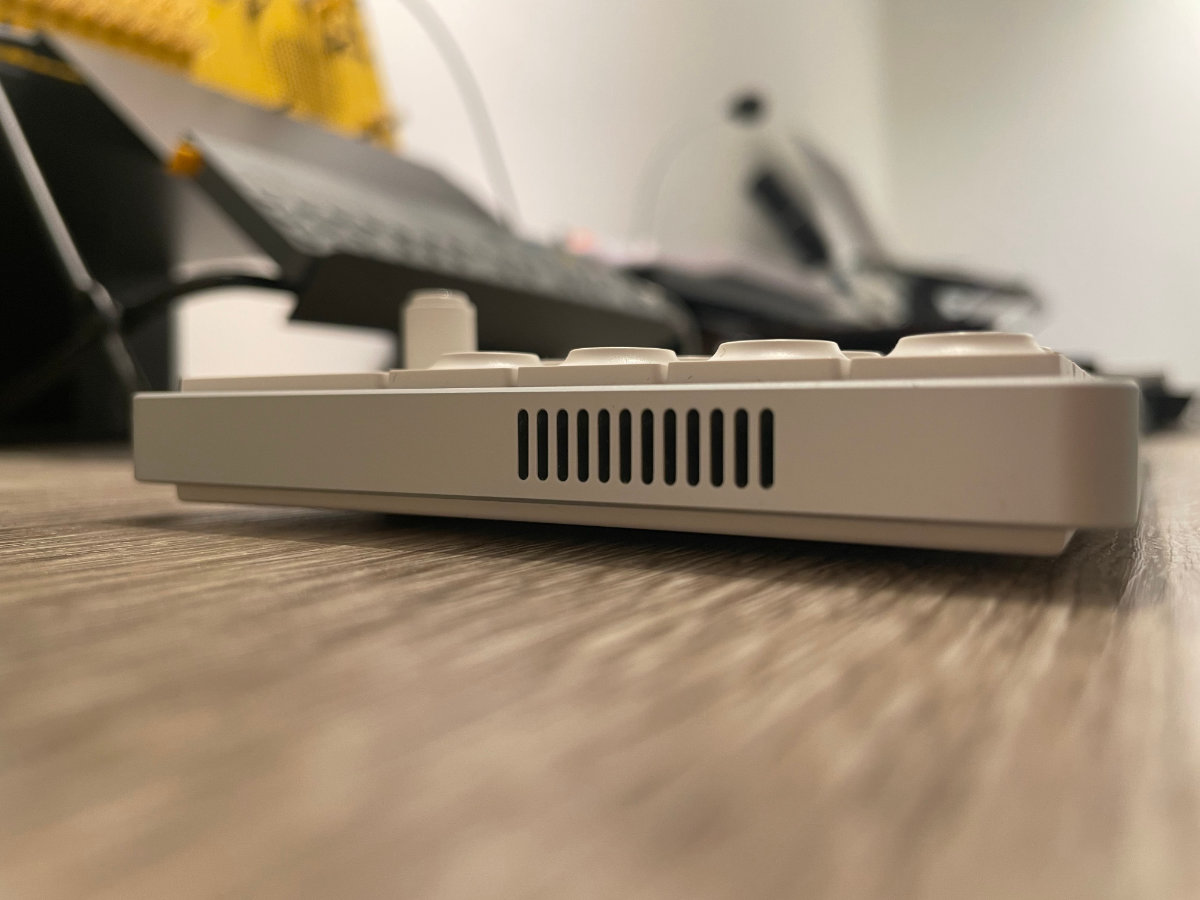
Photo: magazin Mehatronika
Another issue is the way that the tape works with tempo and the grid. There’s no overarching metronome markings on the tape, and there’s no way to get grids which aren’t 4/4-based. The metronome isn’t synced with the grid in any way, so starting recording or playback from any point except from a marking will cause the metronome to fall out of sync. Again, there are moments when this is useful, but switching between the two modes and allowing custom grids would make the entire music-making process much, much more straightforward.
Perhaps the biggest downside of the OP-1 field lies in its 2,000€ price point, which opens the door to many competitors. First and foremost, the most direct one is te’s own original OP-1 model, retailing for a less steep 1,299€, while offering many of the features. Still, with some highly useful updates and a much more perspective future, the OP-1 field remains a good investment.
The OP-Z might look like another contender, at around one fourth of the price, and for some people it might be the preferred choice, but its workflow feels much more like a traditional groovebox, with a focus on sequencing (which is much more powerful than here) but with less sound design potential (however, there’s still plenty to be liked there). The OP-Z is much more suited as the MIDI heart of a DAW-less setup, while the OP-1 shines as one of the lead melodic instruments.
A MacBook Air with a copy of Logic Pro runs for less than the OP-1 field. Sure, it isn’t as portable and isn’t as quirky, and it’s difficult to model the behaviour of the OP-1 with the set in stone paradigms of a desktop DAW, but overall, it’s undeniably a more powerful system, capable of much more powerful projects. Still, we’d argue that the OP-1 isn’t meant to replace a DAW, but to provide a fundamentally different, rather unconventional workflow.
Some other options also include the Elektron Digitone, Polyend Tracker and the MPC series of hardware workstations, all of which retail for less. But as similar in capability as these devices are, the OP-1 field has the most charm of the bunch, offering a very unique set of features. It’s an inspirational device, both in terms of hardware and software design. Using it is an exciting and rewarding experience, often pushing users into uncharted sonic land.
The following examples are of track sketches fully created using just the OP-1 field.
Another thing which cannot be understated is the portable size. There’s not another hardware synth which offers more features yet fits in a backpack. For on-the-go music creation, and especially for creating short sketches when inspiration strikes, the OP-1 is unrivalled.
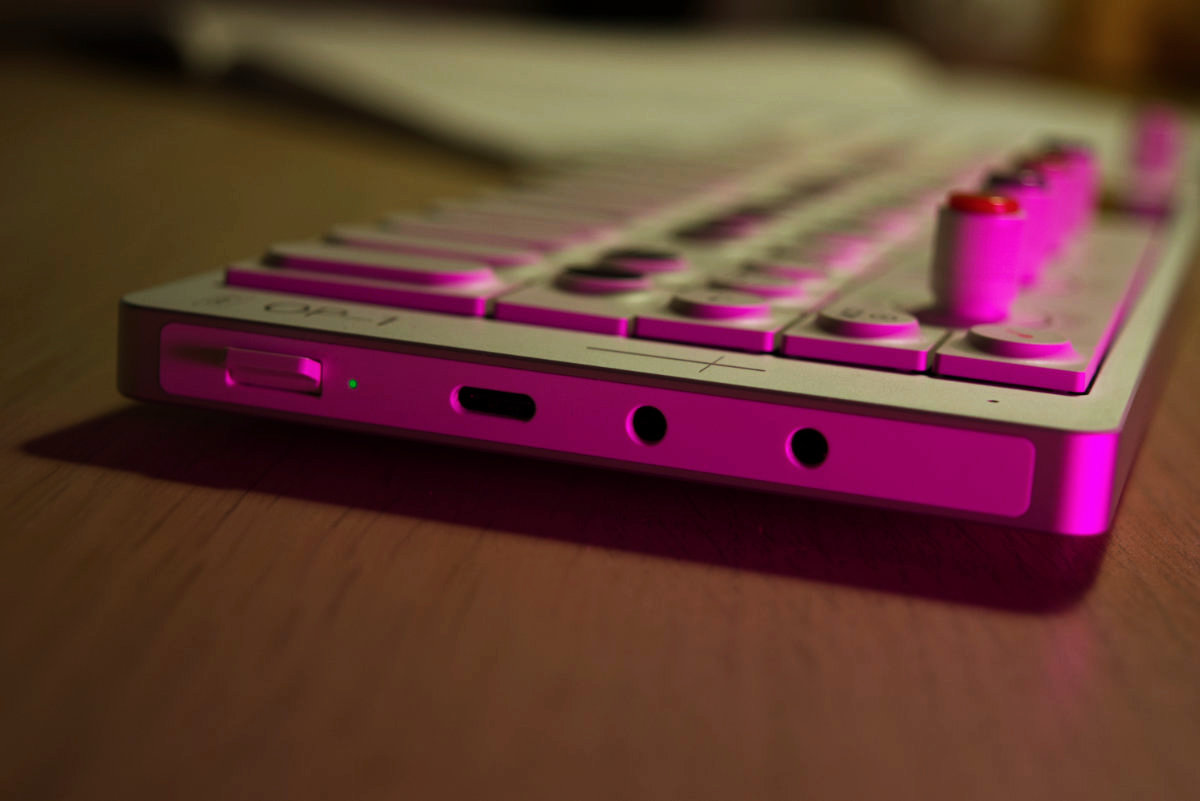
Photo: magazin Mehatronika
teenage engineering’s new flagship synth is the successor the older OP-1 always deserved, preserving all of the authentic spirit of its predecessor while readying the terrain for years and years of further refinement via software updates. Like the older model, the OP-1 field is not the be-all and end-all hardware workstation — and it’s not trying to be that, either — but a unique take on the music creation process as a whole. It’s not a device for everyone, and we’d urge people not to pick it up as their first bit of hardware, but for those already in the field, interested in trying something unique yet incredibly powerful — or those needing a professional on-the-go workstation, the OP-1 field might just be the dream device.
More information: https://teenage.engineering
- LattePanda Mu review - 07/23/2024
- SunFounder Pironman 5 review - 07/11/2024
- Clockwork Pi DevTerm review - 04/24/2024




